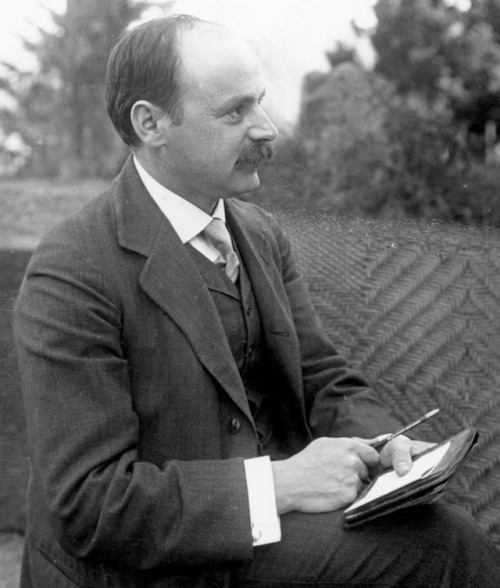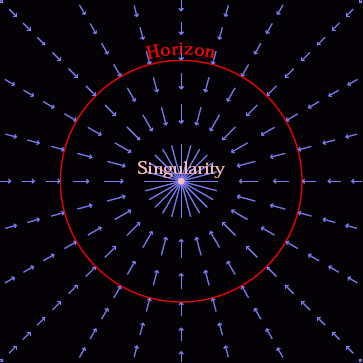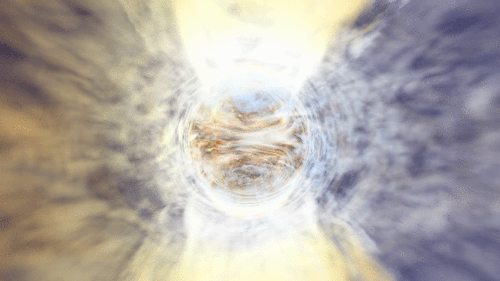Csmsdust

More Posts from Csmsdust and Others


cognoscit







Karl Schwarzschild
He provided the first exact solution to the Einstein field equations of general relativity, for the limited case of a single spherical non-rotating mass, which he accomplished in 1915, the same year that Einstein first introduced general relativity. The Schwarzschild solution, which makes use of Schwarzschild coordinates and the Schwarzschild metric, leads to a derivation of the Schwarzschild radius, which is the size of the event horizon of a non-rotating black hole.
Schwarzschild accomplished this while serving in the German army during World War I. He died the following year from the autoimmune disease pemphigus, which he developed while at the Russian front. Various forms of the disease particularly affect people of Ashkenazi Jewish origin.
Asteroid 837 Schwarzschild is named in his honour, as is the large crater Schwarzschild, on the far side of the moon. (source) (biography) (more)

Archaeologists believe that around 417 cities, towns, and villages made up the unified civilization.
Remains of architectural forms and patterns, ceramics, sculptural art, architectural patterns, and unifying causeway constructions.
The magnitude of the labor int he construction of massive platforms, palaces, dams, causeways, and pyramids dating to the Middle and Late Preclassic periods, suggests a power to organize thousands of workers.
You know. Reading is important. Because I'm like always trying to make every line I write this groundbreaking mindfucking art but like. A book is 90% just saying what happened. "I hugged him around the waist." "The chair was brown and overstuffed." "I woke up alone." Etc etc. Like normal ass lines. I just keep comparing my boring, necessary to set a scene lines, with famous authors' absolute best lines and like.... every line doesn't have to shatter the earth. Sometimes someone just sits in a chair and the lines that wreck you come later, one at a time, here and there. It's alright.
What are Phytoplankton and Why Are They Important?
Breathe deep… and thank phytoplankton.
Why? Like plants on land, these microscopic creatures capture energy from the sun and carbon from the atmosphere to produce oxygen.

Phytoplankton are microscopic organisms that live in watery environments, both salty and fresh. Though tiny, these creatures are the foundation of the aquatic food chain. They not only sustain healthy aquatic ecosystems, they also provide important clues on climate change.
Let’s explore what these creatures are and why they are important for NASA research.
Phytoplankton are diverse
Phytoplankton are an extremely diversified group of organisms, varying from photosynthesizing bacteria, e.g. cyanobacteria, to diatoms, to chalk-coated coccolithophores. Studying this incredibly diverse group is key to understanding the health - and future - of our ocean and life on earth.

Their growth depends on the availability of carbon dioxide, sunlight and nutrients. Like land plants, these creatures require nutrients such as nitrate, phosphate, silicate, and calcium at various levels. When conditions are right, populations can grow explosively, a phenomenon known as a bloom.

Phytoplankton blooms in the South Pacific Ocean with sediment re-suspended from the ocean floor by waves and tides along much of the New Zealand coastline.
Phytoplankton are Foundational
Phytoplankton are the foundation of the aquatic food web, feeding everything from microscopic, animal-like zooplankton to multi-ton whales. Certain species of phytoplankton produce powerful biotoxins that can kill marine life and people who eat contaminated seafood.

Phytoplankton are Part of the Carbon Cycle
Phytoplankton play an important part in the flow of carbon dioxide from the atmosphere into the ocean. Carbon dioxide is consumed during photosynthesis, with carbon being incorporated in the phytoplankton, and as phytoplankton sink a portion of that carbon makes its way into the deep ocean (far away from the atmosphere).
Changes in the growth of phytoplankton may affect atmospheric carbon dioxide concentrations, which impact climate and global surface temperatures. NASA field campaigns like EXPORTS are helping to understand the ocean's impact in terms of storing carbon dioxide.

Phytoplankton are Key to Understanding a Changing Ocean
NASA studies phytoplankton in different ways with satellites, instruments, and ships. Upcoming missions like Plankton, Aerosol, Cloud, ocean Ecosystem (PACE) - set to launch Jan. 2024 - will reveal interactions between the ocean and atmosphere. This includes how they exchange carbon dioxide and how atmospheric aerosols might fuel phytoplankton growth in the ocean.
Information collected by PACE, especially about changes in plankton populations, will be available to researchers all over the world. See how this data will be used.
The Ocean Color Instrument (OCI) is integrated onto the PACE spacecraft in the cleanroom at Goddard Space Flight Center. Credit: NASA
Unusual antibiotic killing mechanism we just published in Nature
Our study about the unusual molecular mechanism behind the antibiotic activity of teixobactin can be read open access here:
https://www.nature.com/articles/s41586-022-05019-y

Figure: The target of teixobactin are bacteria-specific molecules (e.g. they do not exist in human cells) in outer membranes of bacteria. Teixobactin sits on the membrane and aggregates into fibrils, damaging the bacterial membrane and hindering its functions. We got these images by atomic force microscopy that has nanometer resolution. We can see individual teixobactin molecules coming to the bacterial membrane and forming the aggregate.
This is the first star from my research on antibiotics that I started at my postdoc in the Netherlands. More are coming out soon! The very first star was published in Nature, the most read journal in life sciences. I am in scientific heaven!
-
 yakamozcaspian liked this · 2 weeks ago
yakamozcaspian liked this · 2 weeks ago -
 magicpony75 liked this · 1 month ago
magicpony75 liked this · 1 month ago -
 pearls-and-cigarettes liked this · 1 month ago
pearls-and-cigarettes liked this · 1 month ago -
 milkysylveonie liked this · 1 month ago
milkysylveonie liked this · 1 month ago -
 piwoniaaleks liked this · 2 months ago
piwoniaaleks liked this · 2 months ago -
 manyofhorrors2 reblogged this · 2 months ago
manyofhorrors2 reblogged this · 2 months ago -
 chairwaytoheaven reblogged this · 2 months ago
chairwaytoheaven reblogged this · 2 months ago -
 sympangala liked this · 2 months ago
sympangala liked this · 2 months ago -
 usernamesarehard1 reblogged this · 2 months ago
usernamesarehard1 reblogged this · 2 months ago -
 usernamesarehard1 liked this · 2 months ago
usernamesarehard1 liked this · 2 months ago -
 floatingrosepedals liked this · 2 months ago
floatingrosepedals liked this · 2 months ago -
 madd-beat reblogged this · 3 months ago
madd-beat reblogged this · 3 months ago -
 janitorp liked this · 3 months ago
janitorp liked this · 3 months ago -
 shadow-maven liked this · 4 months ago
shadow-maven liked this · 4 months ago -
 anxiouberry reblogged this · 4 months ago
anxiouberry reblogged this · 4 months ago -
 gedemilija liked this · 4 months ago
gedemilija liked this · 4 months ago -
 darknemophilist liked this · 4 months ago
darknemophilist liked this · 4 months ago -
 mariar-r liked this · 4 months ago
mariar-r liked this · 4 months ago -
 kissmeunderparisiansky liked this · 4 months ago
kissmeunderparisiansky liked this · 4 months ago -
 supersonic11 liked this · 4 months ago
supersonic11 liked this · 4 months ago -
 sylvia-marilyn-violet-diana reblogged this · 4 months ago
sylvia-marilyn-violet-diana reblogged this · 4 months ago -
 distopea liked this · 4 months ago
distopea liked this · 4 months ago -
 nezumivc103221 liked this · 4 months ago
nezumivc103221 liked this · 4 months ago -
 mannequinentity liked this · 4 months ago
mannequinentity liked this · 4 months ago -
 cantuscorvi reblogged this · 4 months ago
cantuscorvi reblogged this · 4 months ago -
 harringtonhallofficial reblogged this · 4 months ago
harringtonhallofficial reblogged this · 4 months ago -
 aricianette reblogged this · 4 months ago
aricianette reblogged this · 4 months ago -
 old-school-new-world liked this · 4 months ago
old-school-new-world liked this · 4 months ago -
 distinctanddriven liked this · 4 months ago
distinctanddriven liked this · 4 months ago -
 bigmanosstuff liked this · 5 months ago
bigmanosstuff liked this · 5 months ago -
 gone-to-fight-the-fairies reblogged this · 5 months ago
gone-to-fight-the-fairies reblogged this · 5 months ago -
 haunted-moorland reblogged this · 5 months ago
haunted-moorland reblogged this · 5 months ago -
 calmandcoolasaseacucumber reblogged this · 5 months ago
calmandcoolasaseacucumber reblogged this · 5 months ago -
 swornbrother reblogged this · 5 months ago
swornbrother reblogged this · 5 months ago -
 allidoisstudyandcry reblogged this · 5 months ago
allidoisstudyandcry reblogged this · 5 months ago -
 smallest-turtle reblogged this · 5 months ago
smallest-turtle reblogged this · 5 months ago -
 beautifulasadaisy liked this · 5 months ago
beautifulasadaisy liked this · 5 months ago -
 okonominyaki liked this · 5 months ago
okonominyaki liked this · 5 months ago -
 visambros liked this · 5 months ago
visambros liked this · 5 months ago -
 airsharpshoe liked this · 5 months ago
airsharpshoe liked this · 5 months ago -
 mrs-and-mr-theodore reblogged this · 5 months ago
mrs-and-mr-theodore reblogged this · 5 months ago -
 mrs-and-mr-theodore liked this · 5 months ago
mrs-and-mr-theodore liked this · 5 months ago







